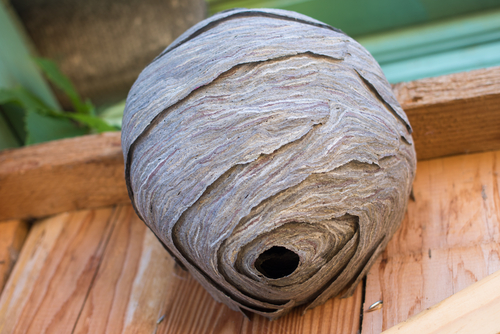A closer look at Bees and Wasps
Bees and Wasps – Ouch!
There are fewer things that can ruin an outdoor activity than stumbling upon a bee or wasp hive. This is particularly true if you have an allergy to bee and wasp stings. For those with allergies, a bee sting can be more than painful, it can be deadly.

Tackling the removal of a bee or wasp hive or nest is not something the average person should attempt on their own. It takes special skills to know how to get rid of stinging pests because when a hive is threatened bees and wasps can attack in swarms, giving the victim multiple stings. If you recognize a hive on your property, contact your pest management professional who specialize in successful bee and wasp removal and prevention.
The Problem: Stinging Pests
There are a large number of bee and wasp species. Nearly every species of bee or wasp is prone to attack and nearly all of them have stingers. These stingers deliver a painful pinch and are loaded with venom. For some a sting means a painful bump, but for others a bee or wasp sting can cause an allergic reaction and anaphylactic shock.
The problem with disturbing a hive when trying to conduct bee removal and especially wasp removal is that the victim can receive multiple stings. If the nest that has been disturbed is a wasp or hornet nest a single insect can sting multiple times, injecting venom repeatedly.
Know the types of bees and wasps
Some species of bees and wasps are prone to sting in large numbers and include:
- Africanized honey bee – or killer bees, are a hybrid between the European and African subspecies, are an excellent example of a stinging insect that can do great bodily harm to humans. Africanized bees are very aggressive, attacking in great numbers upon hearing loud noises or whenever a hive or nest is disturbed.

Courtesy of modernfarmer.com
These bees can be life-threatening not just to those prone to allergic reactions but people (or animals) with limited capacity to escape, such as small children, the elderly or handicapped. If the hive is threatened, these bees can attack in great numbers and have been known to travel 50 yards or more in pursuit of the perceived threat. Hundreds of bees detecting you as a threat can result in hundreds of stings.
- Yellow jackets – probably one of the better-known species of stinging insect. They can pack an extremely painful punch, so it’s better to stay afar of any hive or nest just in case you’ve come across an aggressive species.

Courtesy of en.wikipedia.org
- Hornets – in the wasp family of insects and similar to yellow jackets albeit larger and typically red/brown in coloration, these insects attack when their hives are disturbed, or a drone hornet is killed. Hornets can sting multiple times because their stingers are not barbed like the honey bee, so they are not lost when they sting.

In general, bees are considered beneficial insects that manufacture delicious honey and pollinate plants. However, bees can do extensive damage to a building if they nest inside the walls, and some may sting humans if provoked.
One of the keys to successful bee and wasp removal is identifying the species of bee and wasp. The species and their behaviors determine the most effective way to deal with the hive or nest and remove it.
Common stinging insects include:
- Paper Wasps
- Honey Bees
- Yellow Jackets
- Carpenter Bees
Be Aware of Bee and Wasp Sting Allergies
A portion of the human population is allergic or hypersensitive to bee stings, so just one sting can cause a medical emergency. In rare instances, bee stings can result in life-threatening symptoms, including anaphylactic shock.
It’s best to leave the elimination of nests or hives to Millette Pest Control, as the Centers for Disease Control estimates that 90-100 people in the U.S. die from allergic reactions to insect stings every year.
If you find a lone stinging insect in your home that you feel poses a threat, a quick squirt with an aerosol spray can, such as hairspray, will freeze the insect’s wings rendering it to fall harmlessly to the ground. Just be careful not to touch the stinger.
